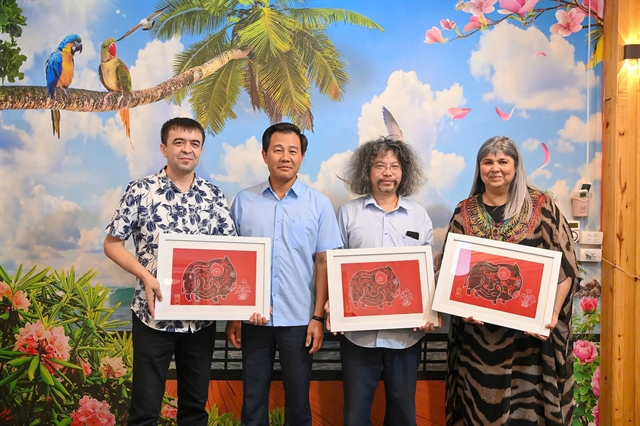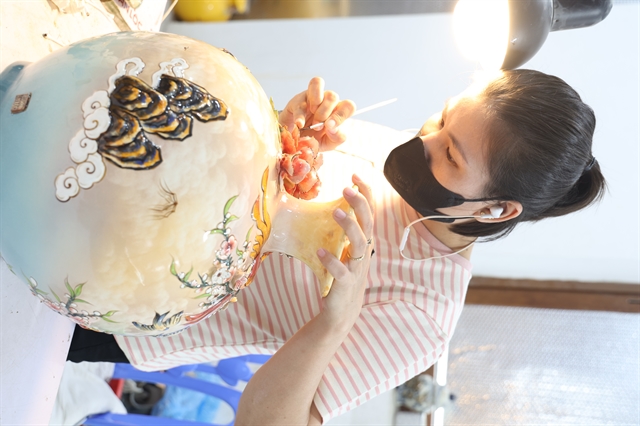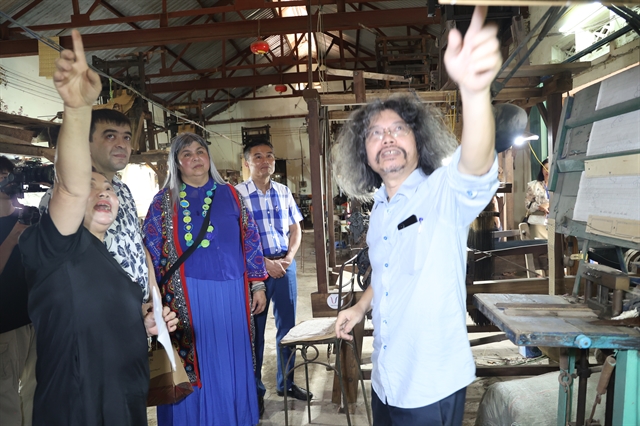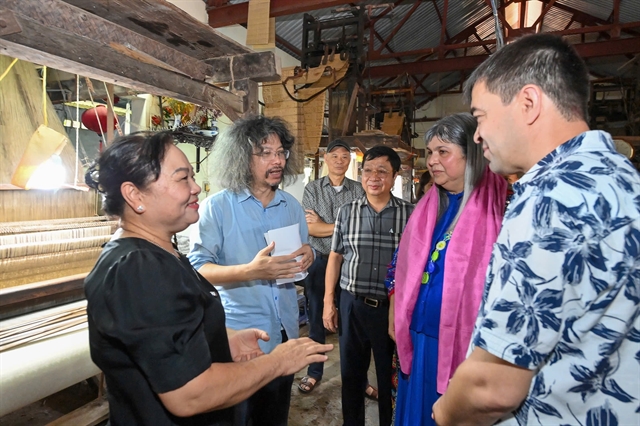
Director of Hà Nội Department of Agriculture and Rural Development Nguyễn Xuân Đại (second from left) takes a photo with members of the World Craft Council's International Jury.
HÀ NỘI — Hà Nội craft villages have made a significant contribution to the economic, cultural and social development of the city.
Hà Nội has been implementing international cooperation activities, bringing a number of craft villages to join the creative craft cities network around the world, aiming at popularising the quintessence of the craft villages to the world and preserving and developing traditional arts as well.
The capital city is home to 1,350 the craft villages accounting for 56 per cent of the total number in the country, of which 334 craft villages have been recognised by the city.

International Jury of the World Crafts Council's members visit Bát Tràng Pottery Village.
Hà Nội's craft village products are diverse in design and of good quality. Many products have been exported to markets such as Japan, South Korea, United States and European countries contributing to increasing the proportion of industrial production value, cottage industry and services, creating jobs for rural workers and leading sustainable socio-economic development for the city.
The city wants its craft villages to be a real highlight in the future and has made preserving and developing them one of the key tasks in the socio-economic development of localities.
Hà Nội craft villages are increasingly attracting domestic and international visitors because of their long-standing cultural values and the creativity of artisans. Craft village products become messages of culture, history and people that Hà Nội City wants to promote to consumers.
Nguyễn Xuân Đại, Director of Hà Nội Department of Agriculture and Rural Development said that: “To become the UNESCO Creative Cities Network’s member, Hà Nội has carried out a plan to upgrade the craft villages.

Bát Tràng villagers have thousand techniques for firing and creating many types of ceramic and pottery products.
“This will contribute to enhancing the position, brand and value of craft villages, helping Hà Nội craft villages to develop sustainably and comprehensively. Additionally, production households in craft villages will also improve their knowledge of producing and trading on a par with other countries around the world.
"At the same time, it will boost the economy, increase incomes, improve the material and spiritual well-being of the people and create opportunities for exchange and integration with craft villages in the Creative Cities Network worldwide."
The department has chosen five craft villages to submit to World Craft Council for UNESCO recognition. These villages are Bát Tràng Ceramic in the Gia Lâm district, Vạn Phúc Silk in Hà Đông District, Phú Vinh Bamboo and Rattan in Chương Mỹ district, Chuông Conical in Thanh Oai and Sơn Đồng Craft Lacquer in Hoài Đức.

The International Jury of the World Crafts Council visit Vạn Phúc Silk Village.
These villages are popular with unique handicraft products and bear witness to their historical and tradition values.
Recently, the International Jury of the World Crafts Council and the department worked together to evaluate two of the villages, Bát Tràng Ceramic Village and Vạn Phúc Silk Village, hoping to win recognition for them as members of the UCCN.
The jury highly appreciated the historical and cultural values of the villages and their contribution to economic and social development as well.
Bát Tràng Ceramic Village is located outside Hà Nội, just 20 minute from the city centre. The village has been producing ceramics and potteries for over six hundred years and residents have thousands of techniques to manage the firing and creation of countless ceramic and pottery products.
Bát Tràng is also where visitors can learn about the art of ceramics in Việt Nam. Despite the ups and downs throughout history, Bát Tràng ceramics have retained their unique beauty and intricacy in every product, enabling these delicate ceramics to increasingly integrate and develop in the global market.
Notably, the beauty and finesse of Bát Tràng ceramics are reflected in the handmade production process on the potter’s wheel, using the technique to create thick ceramic forms, along with the techniques of printing on wooden molds and casting in plaster molds. The five traditional glazes, including blue, brown and crackle glaze, along with decorative patterns, have contributed to the famous brand of the Bát Tràng pottery village.
Vạn Phúc Silk Village is about 10km from Hà Nội centre. Historical documents show that the weaving in Vạn Phúc Village flourished from around the 9th century and today the village is the most beautiful and popular silk-weaving centre in Việt Nam.

The International Jury of the World Crafts Council meet artisan in Vạn Phúc Silk Village. Photos courtesy of Hà Nội Rural Development Department
The silk is soft, light and cool and comes in over 70 types, in all colours and patterns, which reflect Việt Nam's religious beliefs and culture. The designs show things Vietnamese feel close to and identify with, often falling into four categories: animals, plants, items and ideograms. For example, the animals depicted on a famous silk are the Four Holy Beasts: the Dragon, the Qilin, the Turtle and the Phoenix.
Recognising Hà Nội craft villages as members of the global Creative Craft Cities Network is not only a pride for the localities but it also contributes to preserving and promoting traditional cultural values and social economic development for Hà Nội's rural community. — VNS
*This article was written with coordination from the Hà Nội Rural Development Department.
OVietnam